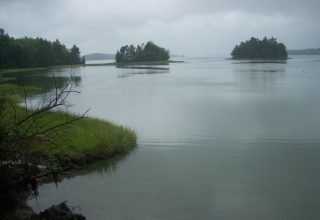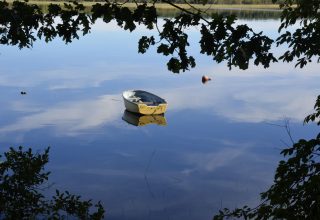
(excerpted from “Integral Leadership Coaching: A Partner in Sustainability” by Lloyd Raines, published March 2007, Integral Leadership Review.)
Formed by gravity over billions of years from fragments of star dust, and made hospitable to life by the evolution of balanced conditions in the atmosphere and land (with the gradual sequestering of toxic elements underground), life forms harnessed the sun’s energy and emerged. The transition from single celled organisms to complex forms, reptiles, mammals, and finally humans occurred within a relatively
short period of geological time. The emergence of civilization is but a moment on the geological clock. And in that moment, we evolved within an extraordinary balance of forces that was largely invisible to us. To a great extent we didn’t appreciate how delicate that balance was or the industrial revolution’s impact on the Earth’s homeostasis. We take for granted the relative stability of climate and weather, just as we do the resources we depend on.
To get a sense of what we take for granted, Paul Hawken, Amory B. Lovins, and L. Hunter Lovins’ (1999, p.1) describe a 1991 scientific experiment that attempted to recreate the conditions of our biosphere. A domed structure was built to replicate the conditions present on Earth. That sealed construction was called Biosphere II. The experiment showed, in part, the extraordinary complexity required for humans to reproduce the complex selfregulating systems that balance the chemistry of air, soil, and water in ways hospitable to life.
They write, …a small group of scientists was sealed inside Biosphere II, a glittering 3.2 acre glass and metal dome in Oracle, Arizona. Two years later, when the radical attempt to replicate the earth’s main ecosystems in miniature ended, the engineered environment was dying. The gaunt researchers had survived only because fresh air had been pumped in. Despite $200 million worth of elaborate equipment, Biosphere II had failed to generate breathable air, drinkable water, and adequate food for just eight people. Yet Biosphere I, the planet we all inhabit, effortlessly performs those tasks every day for 6 billion of us.
Disturbingly, Biosphere I [i.e., our Earth] is now itself at risk. The earth’s ability to sustain life, and therefore economic activity, is threatened by the way we extract, process, transport, and dispose of a vast flow of resources – some 220 billion tons a year As the Biosphere II experiment vividly illustrates, humans live within the earth’s environments and ecosystems, and what we do within that biosphere directly impacts its health and our own, in turn. We are all downstream from what we put into the air, land, and water.
What we collectively put out there, we absorb in here. Our social actions, marketplace decisions (as leaders, producers, and consumers), and ecological concerns are looking for ways to be mutually sustaining and healthy. We are tasked by global warming and climate change to consciously design ways for our living, working, and consuming to be mutually sustainable within our biosphere. To do so, it will require the creation of new assumptions, mental models, stories, and visions of daily life. Consider this excerpt from Natural Capitalism:
Natural capitalism maps the general direction of a journey that requires overturning long-held assumptions, even questioning what we value and how we are to live. Yet the early stages in the decades-long odyssey are turning out to release extraordinary benefits.
Among these are what business innovator Peter Senge calls ‘hidden reserves within the enterprise’—‘lost energy,’ trapped in stale employee and customer relationships, which can be channeled into success for both today’s shareholders and future generations. All three of us have witnessed this excitement and enhanced total factor productivity in many of the businesses we have counseled. It is real; it is replicable… (emphasis added)
I’ve bolded particular phrases in the above excerpt to highlight the common language that characterizes powerful leadership and effective coaching. At the core of leading and coaching is transformation – often including a “journey that overturns long-held assumptions,” “questionin what we value and how we are to live” – to harness “hidden reserves and ‘lost energy’ trapped in stale relationships” to be “channeled
into success for shareholders and future generations.” We might call the process “The Global Journey,” socially responsible education and action, or stewardship for sustainability.
As integral coaches we might ask:
• How might the impact of leadership be enhanced if: a) three or four of the integral quadrants are developed more consciously; b) the authenticity and integrity of leaders included working to respect social and ecological needs; c) leaders were paying attention to the health and morale of the culture as well as the health and well-being of external stakeholders worldwide, beyond bottom line financial concerns; d) systems, processes and practices were regularly assessed and re-aligned for synergy and effectiveness with the organization’s mission and culture?
• What does sustainability look like in our nation’s production and consumption systems? What messages do we receive and promote about what we need, what “the good life” is, and what matters in life? How are we integrating sustainability goals, metrics, and reinforcements into our organizations’ strategic plans? (Likewise how are we integrating sustainability goals into our personal and family life?) How are we engaging in training and education of our whole workforce to tap the collective intelligence, spirit, engagement, and ownership of our mission around sustainability?
• What does transformation look like? Where transformations are needed at this point to get us on a sustainable path? How can we be more efficient, eliminate waste, and recycle everything we use? How are we moving forward to connect the dots between what we see, what could be, and what we’re doing?
• What personal journey calls to us regarding self-attunement with social, ecological, and global attunement – now and for the needs of future generations?
• What impacts do social, economic and ecological trends and tipping points have on the ways leaders lead (and coaches coach)?
• How do we intellectually absorb and emotionally motivate ourselves to act boldly, with visionary goals, and an enlightened self-interest, with the global care needed to address the challenges of sustainability?
• How do we transform the design of organizational structures, systems, processes, practices, and cultures to honor the minimally required dictum: “do no harm”?
• What are the synergy points between our organization’s financial, social, and environmental health and sustainability?
Now, image you are in a leadership coaching role and meeting your client for the first few sessions. How can you discover what quadrants they tend to live in and lead from? What are their operating assumptions that live beneath the surface and direct their behaviors and reactions? Also notice what quadrants you tend to coach from and which ones you might be less comfortable with or attuned to. How might we stretch our awareness and capacity to make distinctions in the depth and span of the four quadrants?
What is Integral Coaching?
Integral coaching is a panoramic, integrated vision of the wholeness of life, within which parts are focused on and developed—for the health, well-being and benefit of the whole. An integral approach is both client-centered and integrally-centered at the same time—holding awareness and bearing witness to what is and what wants to be. Integral coaches help leaders explore ways to connect their individual attunement with their leadership team and ultimately with the whole of the organization’s talent. An integral view stretches conscious awareness of how organizations sit within the larger living systems and how organizational behaviors and byproducts affect the health and well-being of life on the planet. We are human and natural systems within a global commons, living at a particular location at a unique time on this spherical planet. We are the stewards for this incomparable biodiversity of life.
Integral coaches engage leaders in a personalized pilot program of holistic development. We always begin wherever the client is—with their “presenting issues” as identified by the leader. At the same time, we know that these presenting issues are but parts of larger wholes and systems. Indeed, part of the joy and power of coaching and being coached is around this growth that wants to happen. Get anywhere close to the door of growth, and it swings open freely.
Like plants, we lean towards the light (of energy and growth) and will reposition ourselves in that direction if we can find a way. Yet, it is also true that we are habitual creatures with well-worn neural and behavioral patterns. Positive changes are brought about in many ways, just as resistance to change shows up in many forms. Even good ideas, ones we take as “no-brainers” may lay fallow in the face of habits. Consider a few of mine: I should get to bed earlier, but I love reading when the house is quiet late at night. I’m trying to lose weight, but while reading, a few spoonfuls of Haagen-Dazs are just the perfect pleasures after a busy day. I know better, but then…I’ve got competing desires and commitments tugging at each other. I would like
to satisfy both, but they’re mutually exclusive, so – in the interim, I take each day at a time, being at choice point each evening when commitments and desires confront each other. Ultimately, I have to ask myself directly,” Is my long term health of more value to me than the temporary pleasure of eating ice cream?”
Or, for a more substantive example, I’m not crazy about squirreling away a third of my income a year into my IRA savings plan, and it annually creates great stress around tax time. It hurts. But, it is the only way to be personally responsible for the basic financial condition of my life when I hit retirement. With my wife’s disciplined help, generosity, and reinforcement, I somehow manage to sublimate my short-term
self-interested motivations to my long-term interests. I’m amazed that I do it. Long-term need must rise above short-term desires.
To develop behaviors that serve us better, we can call upon clear visioning followed by discipline and willpower, desire for a good retirement or fear of a dependent one. If those are not sufficient to break a habit (and its neural pattern), then we can call on a support community. A coach, colleagues, friends, and family members can be enlisted to help reinforce our intentions by keeping our awareness high and accountability intact or at least moving in the right direction. And, if our actions are at a critical point of self-destructive behaviors, a coordinated intervention may be needed.
At its most basic level, integral coaching is about awakening and cultivating the breadth and depth of what is good, true, and beautiful in the individual, the team, organization, and stakeholders worldwide – through focused development of leaders’ intentions and behaviors, at the individual and social levels. The process of leadership coaching strengthens awareness, deepens understanding, stretches capacity through explorations and experiments with new behaviors, assesses learning and makes corrections along the way. It is about a balanced cultivation of observing with fresh eyes, nonjudgment, curiosity, generosity, assertiveness and receptiveness, and with an eye towards the health and well-being of the whole.
Download Article












